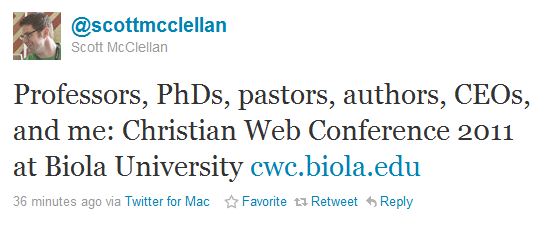Beyond Facts
Take a look at these two sentences
Those two people are married.
And
I now pronounce you man and wife.
Think for a minute – what’s the difference between the two?
The first is simply a statement about the way things are. But the second one is something more than a statement – it’s an action. When a minister says, “I now pronounce you man and wife,” he’s not telling us they are married, he’s actually joining the two people together.
Speech Act Theory
Although we usually think of speech as a transfer of information, linguist John L. Austin argued back in the 1960s that much of our speech should be thought of more in terms of action. When we forgive, confess, encourage, or promise, we are in fact saying words, but those words are actually accomplishing something.
That lead him to spearhead an area of study called “Speech Act Theory.” Austin and other linguists would eventually identify three basic stages that our speech goes through:
- Locution – the simple uttering of words and the surface level meaning of those words
- Illocutionary Force – the action or direction the speaker wants the words to have
- Perlocutionary Effect – the the effect the words have on the hearer and their response
For example, if a spouse says, “Oh, that’s what your wearing?” the surface level locution is a question about what the other person is wearing, but the illocutionary force is one of disapproval, and the perlocutionary effect might be that the other person feels bad and might choose to wear something else.
Or take for example this tweet, by my dear friend and personal mentor Scott McClellan
The surface level locution is a statement of fact about a conference, but under the linguistic hood the illocutionary force is Scott’s trademark self-depreciating humor and a nudge to his followers to go to the conference website. The perlocutionary effect of the tweet are a chuckle and a click.
See What I Did There?
Without you even noticing, I just switched from Speech Acts Theory to (please forgive me) Tweet Act Theory.
What I’m trying to say is our tweets, our facebook statuses, and even our texts, are not always just information transfers – they are often actions with a illocutionary force that produces a perlocutionary effect. We’re not just sharing information, links, and pictures of our cats. The words we type into our phones and computers are often designed – whether we think about it or not – to cause a reaction in others.
Lentin Locutions
As a Protestant, I love to put my personal individual spin on ancient traditions.
And in that tradition of tradition remaking, I would like to suggest that for the next 40 days, from Wednesday, March 9th through Saturday, April 23rd, that think we spend a few more seconds thinking about the forces and effects our tweets (and all other social media updates) will have.
Are my words edifying or self-serving? Are they helpful or destructive? Uplifting or mudslinging? Banal or eternal?
If this sounds like a fun idea, leave a comment or tweet this out. The illocutionary force will be that you’re committing yourself to something and the perlocutionary effect is that someone else might join in!

I love this. Thanks, John. I don’t have a Twitter (last person on the planet?), but the same seems to be true of Facebook status updates.
An great example of this is the dreaded “Vaguebooking” (http://www.urbandictionary.com/define.php?term=Vaguebooking).
That I was largely unaware of the mentoring nature of our relationship demonstrates I make for an aloof (but clearly effective) mentor. Great post, young padawan.
I look forward to reading about the development of “Tweet Act Theory” in a history of linguistics book fifty years from now. Then again, maybe I don’t want to perceive my future as using my time to read history of linguistic books.
Anyway, this is a really interesting post!